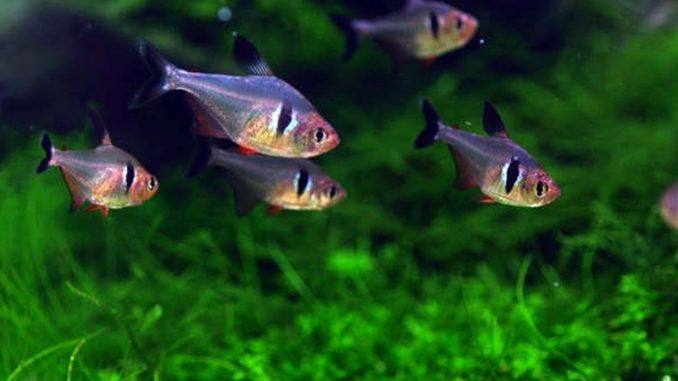
The black phantom tetra is a calm shoaling fish that likes to swim around the midsection of the aquarium. This species of tetra fish is native to the freshwaters of Northern Paraguay and Brazil and is part of the Characidae family of fish.
Aquarists are very attracted to this fish species, as it is extremely easy to care for and looks striking in an aquarium.
The black phantom tetra is compatible with several fish species. Whether you are new to caring for fish, or an expert, this fish will add character to your tank.
TABLE OF CONTENTS
Black Phantom Tetra Facts & Overview
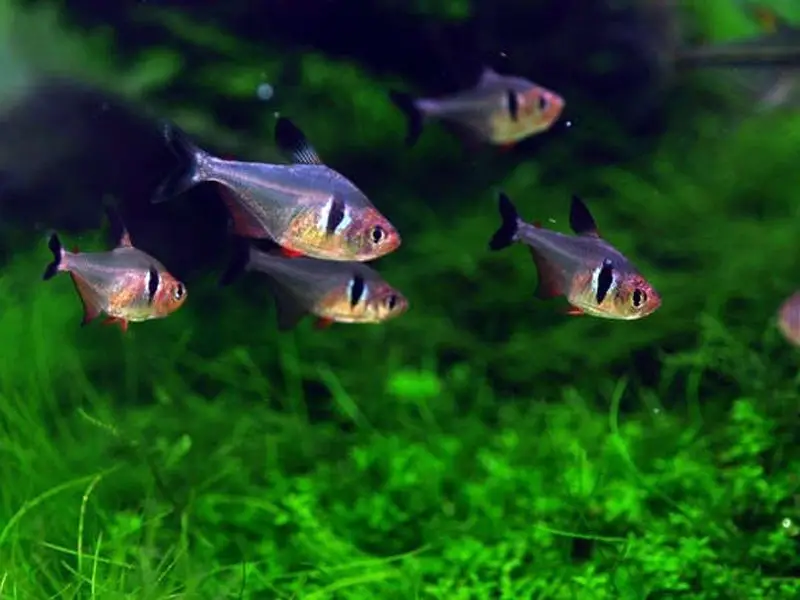
| Category | Rating |
| Care Level: | Easy |
| Temperament: | Calm and peaceful |
| Color: | Black |
| Lifespan: | ~5 years |
| Size: | 1.75~ inches |
| Diet: | Omnivore |
| Family: | Characidae |
| Minimum Tank Size: | 10 gallons |
| Tank Setup: | Freshwater, plants |
| Compatibility: | Compatible with other peaceful fish species |
The black phantom tetra goes by the scientific name of Hyphessobrycon Megaloptera. These fish are referred to as black phantom tetras for short because of their mysterious appearance and the dark marking that resembles an eyepatch behind their gills. This eye patch makes the fish look as if a phantom is watching you.
Wild black phantom tetras are red. Over time, fish breeders took it upon themselves to make the black phantom tetra more physically different from its cousin, the serpae tetra, so the black phantom was developed.
The black phantom tetra’s natural habitat contains plenty of vegetation, especially floating plants and clear water. Keeping the tetra in an aquarium with live plants and clean water will prevent them from becoming distressed and unwell.
Black phantom tetras have long lifespans of up to five years, but if their aquarium is not suitable and doesn’t resemble their natural habitat, they will be more susceptible to infections and diseases.
The black phantom tetra isn’t under threat of endangerment and can therefore be found easily in pet stores across the country. Black phantom tetras typically cost between $3 to $4.50 in pet stores and online.
Appearance & Behavior
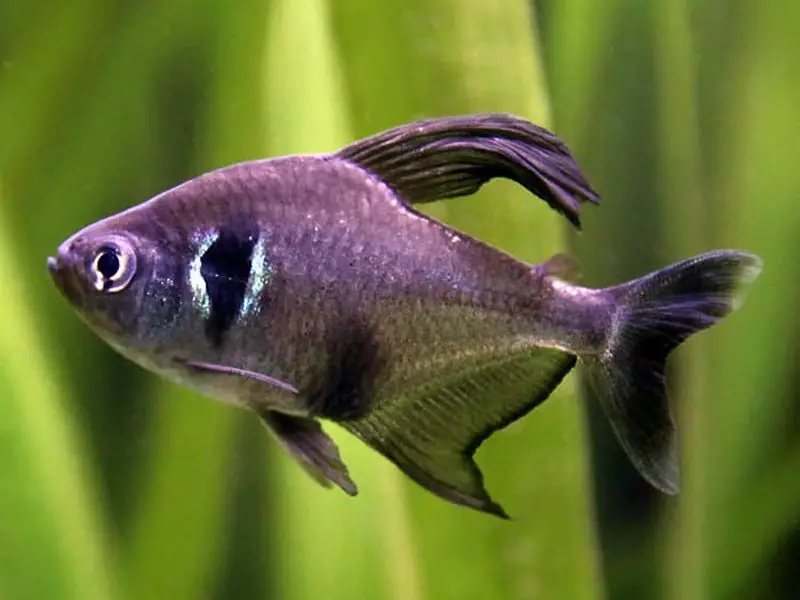
The black phantom tetra fish species has a wider body than other types of tetra fish. Their bodies are flat and oval-shaped, and silver with a touch of black in color. Although it is called a black phantom tetra, the fish isn’t very dark and looks more gray in certain lighting.
Aquarists often choose the black phantom tetra for aesthetic purposes. This tetra looks fantastic and makes an interesting contrast from other brightly colored fish that you can get for your freshwater aquarium.
Distinguishing between male and female black phantom tetra fish is easy and can be done by comparing their fin lengths. Males have elongated fins and tails, whereas the females look stumpier and have a stocky build.
Female fish become bloated and puffy when breeding or pregnant, which is also a tell-tale way that helps distinguish the males from the females. Both male and female fish have tall dorsal fins and fork-shaped tail fins.
Stressed fish will look dull and lethargic. The black phantom tetra’s eyes become cloudy, and they may show signs of infections or diseases caused by distress and unsuitable tank conditions.
Typical Behavior
Black phantom tetra fish are shoaling fish that like to be kept in groups and often swim around the tank together. The tetra is a peaceful fish, but they will nip and bite other fish if they feel threatened or if they get in their way.
These fish get on well with other shoaling fish that display similar swimming habits and personality traits, such as the harlequin rasbora.
Males will become territorial at times, especially if there are other female fish around. Keeping an appropriate ratio of males and females is vital to ensure the male fish in the tank don’t bicker.
Biting and fin nipping are typical signs to look out for that indicate your black phantom tetras are under stress or feel threatened. When a black phantom tetra is calm and happy, it will stay in the mid-section of the tank and swim slowly alongside other black phantom tetras in the tank.
Black phantom tetras are active in the daytime and will look for cover and safety during the night. Keeping an appropriate day to night cycle is vital, so use plants to provide the fish with cover and appropriate lighting for the time of the day.
If you can’t see your black phantom tetra, it is probably hiding and resting in a corner of the tank. These fish aren’t shy, but it is important to provide them with sufficient hiding places and live plants so that the tetra feels comfortable and safe.
Black Phantom Tetra Care
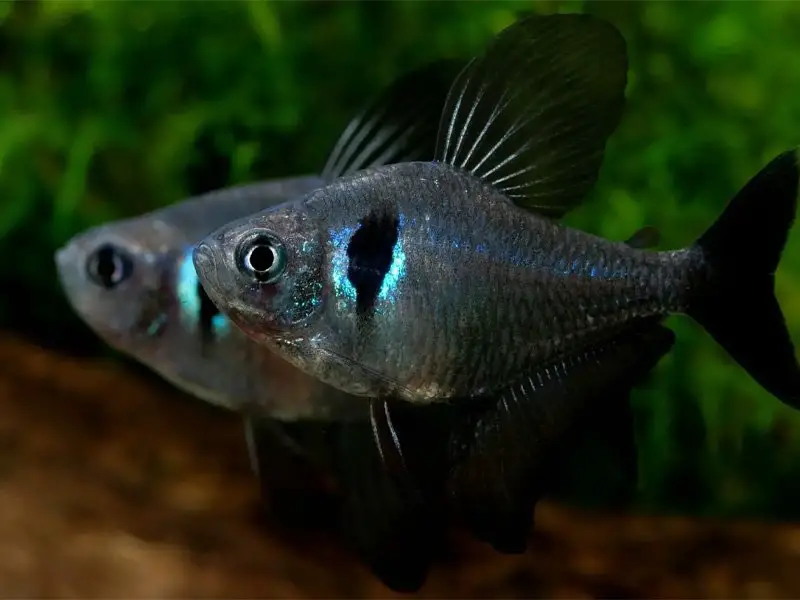
Caring for black phantom tetras is easy, especially if you follow a care guide. As long as the water parameters and tank conditions are as they should be, these fish should live a long and happy life.
The black phantom tetra lives in the freshwater of the Guaporé River basin and Rio Sao Francisco and can also be found in the wetlands of Pantanal. Rich vegetation and clear water are ideal for your black phantom tetra tank.
Although these fish are hardy, they are still prone to the usual aquarium fish diseases that are common throughout freshwater and saltwater fish. Keeping new fish in quarantine and performing regular water changes will reduce the chances of your fish getting sick.
Habitat and Tank Requirements
Mimicking the environment that black phantom tetras will find in the wild is key to keeping them healthy and happy. Tetras like living in a highly vegetated aquarium, with soft lighting and accessories such as dried driftwood and other natural ornaments.
The following are some great plants for a black phantom tetra tank:
- Hornwort
- Java moss
- Duckweed
- Water wisteria
- Amazon frogbit
Don’t forget that black phantom tetra fish swim around the middle of the tank. When designing and aquascaping the tank, make sure there is plenty of space in the center for your fish to swim freely and comfortably.
Tank Conditions
Here are the desired tank conditions for black phantom tetras:
- Water type — Black phantom tetras are freshwater fish, which means you can use tap water to fill up your tank. Never use distilled water for your fish tank as the mineral levels are not ideal for your fish.
- Tank size — Black phantom tetras should live in 10-gallon fish tanks or larger. Although these fish are small, there are usually plenty of them and other fish species in the tank, so they need plenty of space to swim freely.
- Ideal water temperatures — Black phantom tetras need to live in water with temperatures between 72 and 82 degrees Fahrenheit. Keeping the water temperatures as constant as possible is key for maintaining optimal fish health, so although these fish can tolerate fluctuating temperatures, you should check the tank’s temperature daily and stop it from changing more than one or two degrees.
- Substrate — Dark river sand is perfect for black phantom tetra fish tanks.
- Plants and decorations — Decorate the tank with dried leaves and driftwood rather than plastic accessories. Plastic accessories will not harm your fish, but they won’t benefit them as much as adding natural organic matter to the water.
- Water pH levels — Black phantom tetras should swim in water with a pH level between 6 and 7.5
- Filters and bubblers — Use a peat filter for black phantom tetra fish tanks.
Tank Mates
Black phantom tetras are easy-going fish that like to share a tank with other peaceful fish. When choosing tank mates for the black phantom tetra, avoiding highly territorial fish will help keep the peace in the tank.
Here is an overview of the best tank mates for the black phantom tetra fish:
- Honey gouramis
- Danios
- Rasboras
- Non-aggressive cichlids
Be cautious when introducing cichlids into your aquarium. They can be incredibly territorial, and some species are aggressive. Only introduce cichlids into your black phantom tetra tank if you are an experienced fishkeeper.
As a general rule, stick to easy-going bottom dwellers and other tetra species of fish in a black phantom tetra fish tank. Once you are feeling more confident in your abilities, you can introduce more challenging fish.
Diet and Feeding
In the wild, black phantom tetras will feed on insects, worms, and crustaceans. However, the fish in your tank should eat high-quality fish flakes and pellets for optimal health.
Most fish keepers find it easier to make a fish feeding schedule and stick to the times quite rigidly as tetra fish tend to overeat.
Feed your black phantom tetra fish flakes three times per day (choose the hours that work best for you) and feed them a snack once daily of brine shrimp, mosquito larvae, or bloodworms. These snacks can be freeze-dried or live.
Disease
Ich, bacterial infections, flukes, and parasites are common black phantom tetra infections and diseases. These are very simple to treat and require 25 percent water changes as maintenance and treatment every other week.
Keeping new fish in a quarantine tank is a great way to prevent infections. However, this isn’t always possible as maintaining a separate tank is time-consuming and costly.
Breeding
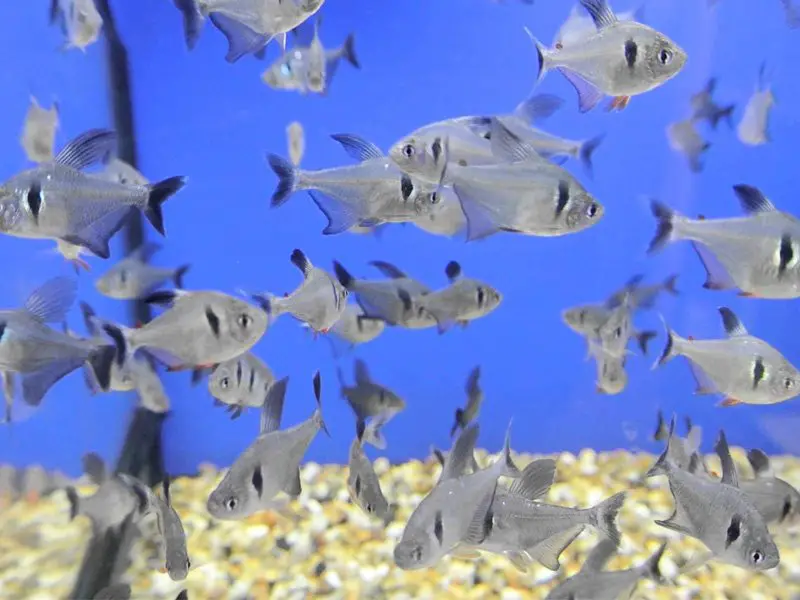
Black phantom tetras will breed without hassle in captivity. Females can lay up to 300 eggs if they are healthy.
In order to successfully breed your fish, isolate the fish in a separate spawning tank.
Here are some tips and step-by-step instructions for successfully breeding these fish:
- Decorate the tank with live plants — Plenty of floating live plants and natural vegetation will help get the fish in the mood.
- Add suitable lighting — Low lighting has been proven to help black phantom tetras begin their spawning rituals. Placing the breeding tank in a quiet room will also prevent the fish from becoming distracted.
- Keep the water temperature warm — Spawning fish appreciate water temperatures that are on the higher end of the scale of the acceptable temperatures. This is also true for eggs and fry.
- Reduce the pH level to 5.5 — Reduce the pH level in the water and lower the water hardness for spawning fish.
- Leave the fish to spawn — Leave the male and female fish alone to spawn once all of the water parameters and tank conditions are on point. Feeding the spawning pair with live food like mosquito larvae or bloodworms will help them.
- Use a breeding box to separate the eggs from the fish — Finally, keeping the eggs and fry safe once the fish have spawned and laid their eggs is crucial. Breeding boxes are cost-effective ways of keeping fry and eggs away from adult fish.
Should You Get a Black Phantom Tetra for Your Aquarium?
Before deciding whether a black phantom tetra fish is right for you, think about what you are looking for in a tank. If you’d prefer a community tank, the blank phantom tetra could be perfect.
Despite the difficulty of caring for more than one species of fish in a tank, it is very rewarding. Black phantom tetras are fun fish to observe in an aquarium, and they will give you years of pleasure, especially if you decide to breed them somewhere along the line.


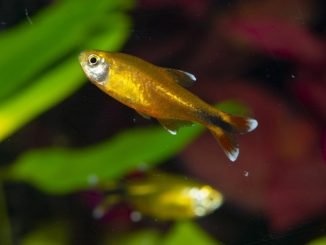
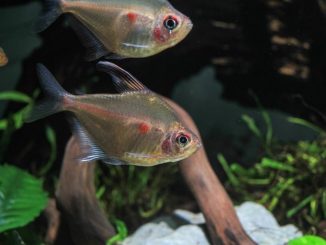

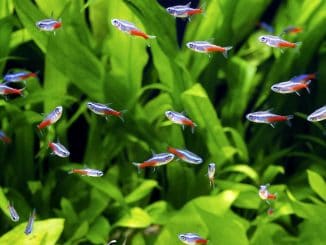
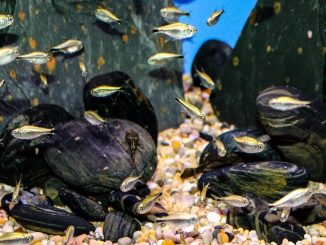
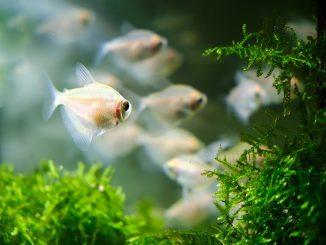
Keeping plants in the aquarium is mandatory. Is it possible to keep the Phantom Tetra in unplanted tank only with large stones?